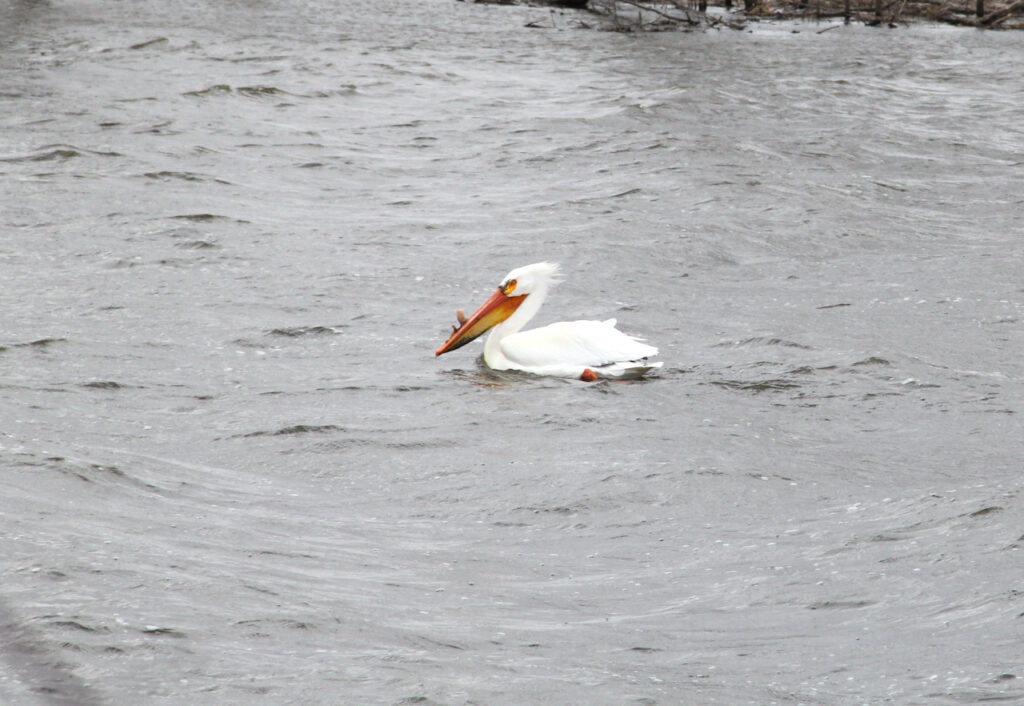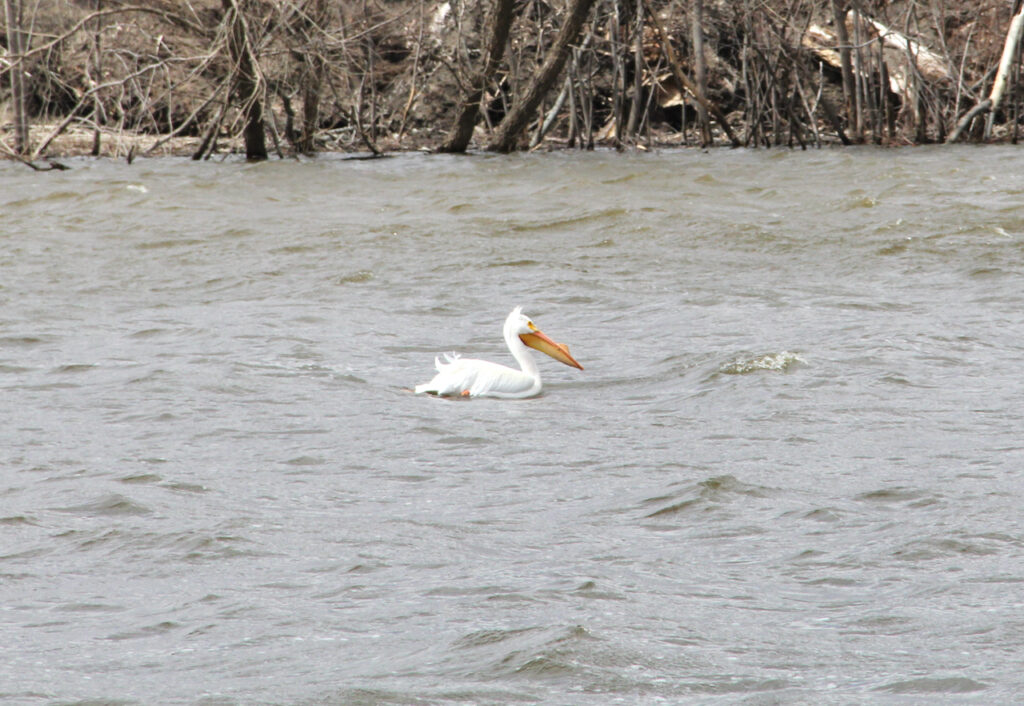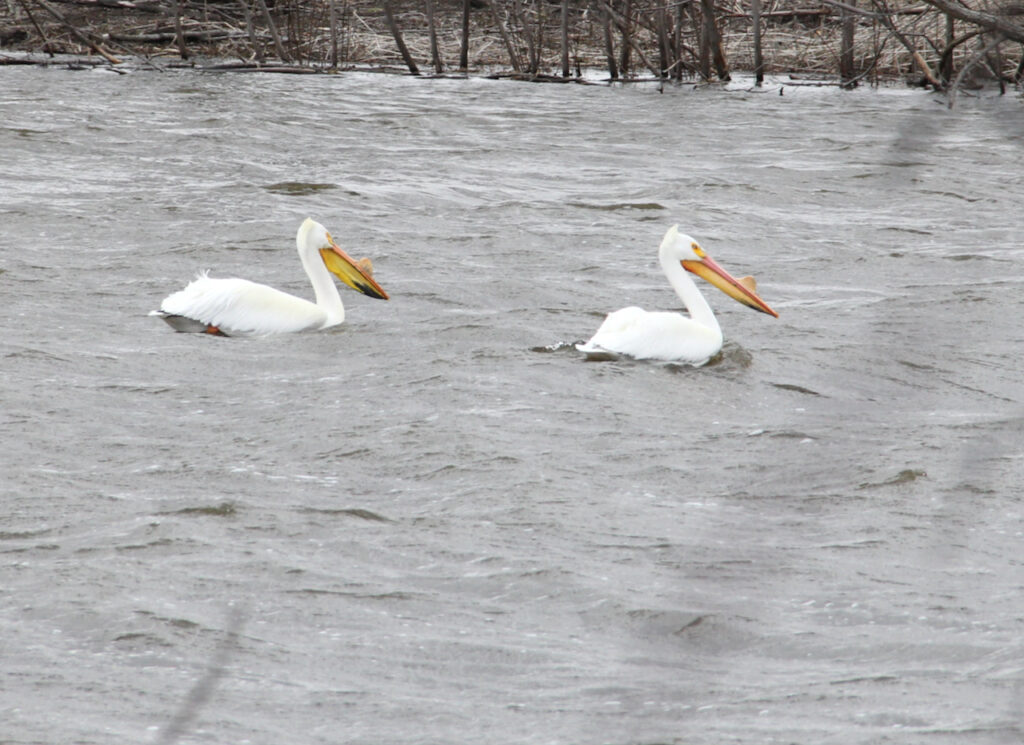By Kim McDarison
Those living around the Rock River in the Jefferson County area have reported seeing white American pelicans.
According to Ryan Brady, a Wisconsin Department of Natural Resources (DNR) Natural Heritage Conservation Program biologist, in the southwest quadrant of the state and along the Mississippi River corridor they arrive in Wisconsin every year, he said, noting that they come “in very good numbers.
“Then we have them around through the summer, but more of them are around this time of year. Some are migrants stopping to rest and feed,” he said, adding, for some people the occurrence seems strange: “They are supposed to see them on the ocean, right? but that’s a different species; they are brown pelicans.”
Brady described the white American pelican as an interior bird.
“They winter in warm areas like Florida and Mexico and come back to places like Wisconsin in March and April, and then leave again in September and October. Some linger longer even through the ice-up, but the vast majority are gone in early fall,” he said.
The number of pelicans arriving in Wisconsin and neighboring states has increased over the last several decades, Brady said.
While he was unable to pinpoint why that has occurred, he cited as possibilities the disuse of DDT, which, he said, might have played a role in thinning the birds’ eggs.
Also, he said, in past decades, “we lost a lot of wetlands that they needed for habitat and now we are smarter about wetlands.”
Brady pointed to a project called: “The Wisconsin Breeding Birds Atlas,” which, he said, was most recently completed in 2019.
The project collected five years worth of data using volunteers throughout the state who contributed bird observations.
“They looked for such things as where nesting sites were. An earlier installment of the atlas was performed in the 1990s. It was a similar project to the one completed in 2019, so it was like repeating the snapshot,” he said.
He added: “In the case of pelicans, we saw significant increases in the number of breeding sites and where they simply occurred.”
Addressing recent concerns associated with avian influenza, Brady said that while waterfowl are the most susceptible among bird species, in Wisconsin, to date, as of the last few days when he last checked, there have been no cases of avian flu reported in white American pelicans.
He encouraged bird watchers to continue to enjoy bird sightings, advising: “We should be vigilant about watching birds, and not just pelicans. We know the avian flu is out there and the pelican is a species that could be impacted.”
Brady writes a monthly “Statewide Birding Report,” which is available on the DNR website. As of April 6, he reported the following:
Despite weather more fit for winter at times, spring bird migration slowly rolls on across Wisconsin.
The first wave of short-distance migrating land birds has reached southern Wisconsin, including rusty blackbird, brown-headed cowbird, fox sparrow, eastern phoebe, yellow-bellied sapsucker, northern flicker, winter wren, eastern bluebird, yellow-rumped warbler and both ruby-crowned and golden-crowned kinglets. Dark-eyed juncos remain in high numbers, uneager to depart due to extensive snow cover up north. American robins, common grackles, red-winged blackbirds, and other species are similarly behind schedule for northern birders.
Common loons have arrived at southern lakes, where their numbers will build in the weeks ahead as they wait for extensive ice cover to retreat from northern lakes. Trumpeter swans have been seen by the dozen in western and northern Wisconsin. Tundra swans have been reported by the hundreds or even thousands in flooded fields and other wet areas of southern and eastern Wisconsin. Some greater white-fronted geese continue to be seen, while Canada geese have only trickled into northern regions.
Duck migration is underway – it has yet to peak in southern Wisconsin and has barely reached the north. Arrivals include wood duck, hooded merganser, blue-winged teal, scaup, ring-necked duck and nearly every other species that migrate through the state. American white pelicans are back in the south, as are pied-billed and horned grebes, American coots and a few red-throated loons at multiple Lake Michigan vantages. Arriving shorebirds include killdeer, Wilson’s snipe, lesser and greater yellowlegs and black-necked stilt. Great blue herons have returned to nesting rookeries and wetlands, the latter also hosting its first great egrets, American bitterns, and whooping cranes.
Now is an excellent time to visit brushy fields or woodland edges at dusk to witness the American woodcock courtship flights. Wild turkeys are also displaying, ruffed grouse drumming and both sharp-tailed grouse and greater prairie chickens have begun to dance on leks.
April is also prime time to view resident and migrating raptors. Eagle migration is past its peak, but many red-tailed hawks are currently moving through or nesting. Merlins and peregrine falcons have returned, as have ospreys, turkey vultures and red-shouldered hawks. Look for broad-winged hawks to arrive around April 15-20, with large numbers toward the end of the month. Young great horned owls are leaving nests, barred owls have active nests with eggs or young and snowy owls have begun to depart.
White-winged crossbills continue at spruces statewide, while northern birders reported the last pine grosbeaks this past week. Feeder activity remains busy with American goldfinches, house and purple finches, pine siskins and American goldfinches among other regulars. Common redpolls continue statewide, although in much smaller numbers across southern Wisconsin. However, in the north woods, they continue by the hundreds and will likely persist through the month, making for an expensive bird feeding season.
Although songbirds generally are at low risk of highly pathogenic avian influenza, redpolls and other birds that congregate at feeders are susceptible to salmonellosis at this time of year. This bacterial disease is transmitted through feces. Signs often include a puffed-up, lethargic individual that doesn’t fly away with the rest of the flock. If a sick or dead songbird is found near a feeder or birdbath, remove the feeder or birdbath, wash and disinfect it using a 10% bleach solution and wait at least a week before putting it back up. It is also recommended to clean, bag and dispose of any waste seed from the ground. If five or more songbirds are found sick or dead, please report them using our Wildlife Health webpage’s guidance.
April and May promise to be exciting months for birdwatching. Look for an influx of migrants Sunday into Monday before north winds and rain potentially settle in again next week. Are you thinking of orioles, hummingbirds, and warblers? Late April into early May is the typical arrival for those favorites in southern Wisconsin. Help us track the migration by reporting your sightings to www.ebird.org/wi.

A white American pelican navigates the Rock River Thursday as viewed from Rock River Road in the town of Koshkonong.

A pod of pelicans gathers along the shore of the Rock River Thursday.

A white American pelican swims upstream.

A pair of pelicans find their way through relatively choppy waters.
Chris Spangler photos.
This post has already been read 5931 times!
